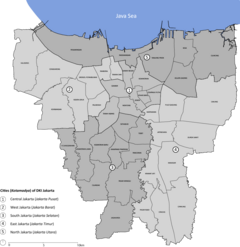Pancasila Building
| Pancasila Building | |
|---|---|
Gedung Pancasila | |
 The front facade of Pancasila Building | |
 location within Jakarta | |
| Former names | Residence of Hertog Bernhard; Volksraadgebouw |
| General information | |
| Status | used as museum |
| Type | |
| Architectural style | Indies Empire style |
| Location | Jakarta, Indonesia |
| Address | Jl. Pejambon No. 6, Jakarta 10410 |
| Coordinates | 6°10′28″S 106°50′1″E / 6.17444°S 106.83361°ECoordinates: 6°10′28″S 106°50′1″E / 6.17444°S 106.83361°E |
| Construction started | early 1830s[1] |
| Design and construction | |
| Architect | J. Tromp |
Pancasila Building (Indonesian: Gedung Pancasila) is a historic building located in Central Jakarta, Indonesia. The name Pancasila refers to the speech delivered by Sukarno in the building on which he explained the concept of Pancasila, a philosophical concept which would be the foundation of the Indonesian Nation, on June 1, 1945. Built in the early 1830s, the building is one of the many 19th-century colonial landmarks in Jakarta. The Pancasila Building currently belongs and is under the preservation of the Indonesian Ministry of Foreign Affairs.
History[]

The building was originally located in the Weltevreden neighborhood, a parcel of land acquired by Cornelis Chastelein on 6 March 1697 on the east side of the bovenstad (the Upper Town) in what is now the area to the east of Merdeka Square.[2] It was built in 1830 as a residence for Prince (Hertog) Bernhard van Saxe-Weimar-Eisenach (1792-1862), a German-born Dutch Royal Army Commander.[3] It was designed in a Neoclassical Empire Style on the east bank of the Ciliwung. The adjacent park and street Hertogspark (also called Jalan Pejambon) was named after him.[3]

In 1918, the building housed the Volksraad of the Dutch East Indies, the first national-level council which included native Indonesian representation. It received the name Volksraadgebouw or Building of the Volksraad).[1]
With the dissolution of the Volksraad during the Japanese occupation in 1942, the building was re-purposed for the Investigating Committee for Preparatory Work for Independence (Indonesian Badan Penyelidik Usaha-usaha Persiapan Kemerdekaan or Dokuritsu Zyunbi Tyoosakai).[3]
After the independence period, in early 1950, the building was transferred to the State Department, and then to the Ministry of Foreign Affairs. It was renamed Gedung Pancasila or Pancasila Building on June 1, 1964. During the 1960s, the building was used to educate prospective diplomats. Today, the building is mainly used for important ceremonies of the Ministry of Foreign Affairs.[1][3]
References[]
- ^ Jump up to: a b c Merrillees 2015, p. 45.
- ^ Anonymous, Kaart van Batavia, tusschen de Groote Zuyderweg en langs de Mokervaart.
- ^ Jump up to: a b c d Shahab, Alwi (December 31, 2015). "Gedung Lahirnya Pancasila, UUD 1945, dan Piagam Jakarta". republika.co.id. Repulika. Archived from the original on September 12, 2016. Retrieved September 12, 2016.
Cited works[]
- Kaart van Batavia, tusschen de Groote Zuyderweg en langs de Mokervaart [Map of Batavia, Between the Great southern road and along the Mokervaart] (Map) (in Dutch). Cartography by Anonymous. Kaartcollectie Buitenland Leupe. 1700s. Retrieved November 4, 2016.
- Merrillees, Scott (2015). Jakarta: Portraits of a Capital 1950-1980. Jakarta: Equinox Publishing. ISBN 9786028397308.
See also[]
- Batavia, Dutch East Indies
- List of colonial buildings and structures in Jakarta
- Buildings and structures in Jakarta
- Colonial architecture in Jakarta
